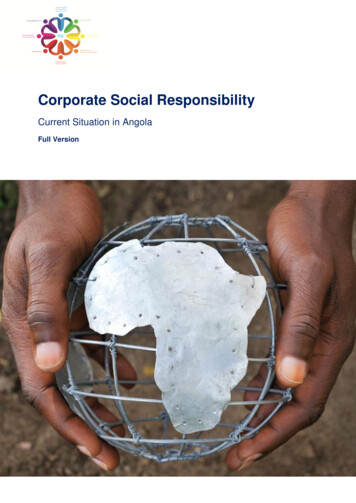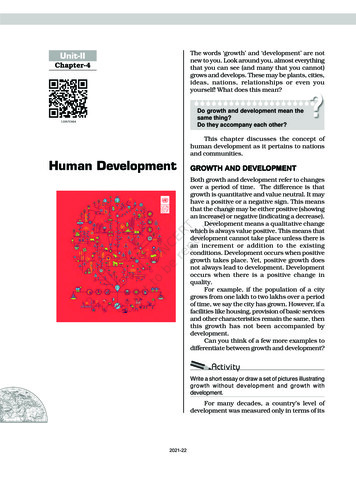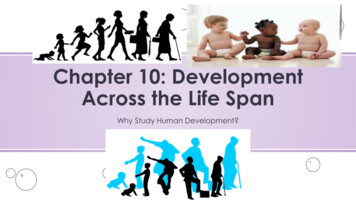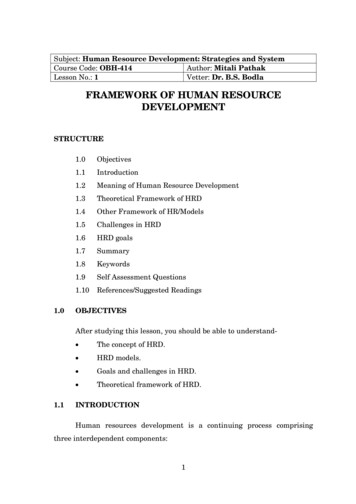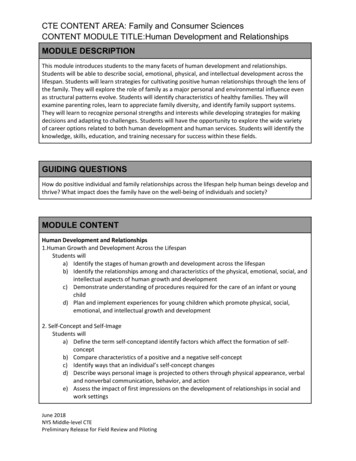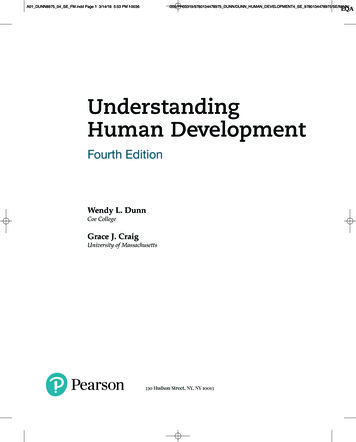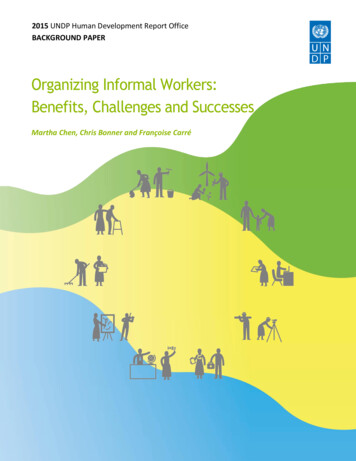
Transcription
2015 UNDP Human Development Report OfficeBACKGROUND PAPEROrganizing Informal Workers:Benefits, Challenges and SuccessesMartha Chen, Chris Bonner and Françoise Carré
Organizing Informal Workers: Benefits, Challenges and SuccessesMartha (Marty) Chen is Lecturer in Public Policy at the Harvard Kennedy School, an Affiliated Professorat the Harvard Graduate School of Design, and International Coordinator of the global research-policyaction network Women in Informal Employment: Globalizing and Organizing (WIEGO). An experienceddevelopment practitioner and scholar, she specializes in employment, gender and poverty with a focuson the working poor in the informal economy. Dr. Chen was awarded the Padma Shri award by theGovernment of India in 2011, and a Friends of Bangladesh Liberation War award by the Government ofBangladesh in December 2012.Christine (Chris) Bonner is Director, Organization & Representation Program, WIEGO. She spent 20 yearsworking in trade unions in South Africa. In 1997, she became the founding director of the trade unioneducation institute DITSELA, based in Johannesburg. At WIEGO, she focuses on informal workers’networks and networking globally and regionally, capacity-building activities, and projects on law andinformality.Françoise Carré is Research Director of the Center for Social Policy at the University of MassachusettsBoston J. W. McCormack Graduate School of Policy and Global Studies. She coordinates research forWIEGO, and specializes in applied labour economics, industrial relations and comparative employmentpolicy, as well as studies of community-based organizations. She has written extensively abouttemporary, short-term and informal work in the United States and globally.ABSTRACTThe informal workforce represents more than half of all workers in most developing countries and asignificant share of workers in developed countries. This paper summarizes the history and forms oforganizing informal workers, providing a timeline of organizing, typologies of organization forms andstrategies, and data on numbers of organizations by type, sectors and countries. It discusses whatdifferent groups of informal workers bargain or negotiate for, and with whom; and analyses thestrategic goals, benefits and challenges of organizing. It presents some recent legal and policy victoriesby organizations of informal workers. The concluding section extracts some lessons learned and makesa few recommendations, especially for governments and policy makers.22015 Human Development Report OfficeBACKGROUND PAPER
Organizing Informal Workers: Benefits, Challenges and SuccessesIntroductionThe informal workforce comprises both the self-employed in informal enterprises (i.e.,unincorporated or unregistered enterprises) as well as wage workers in informal jobs (i.e., withoutsocial protection through their work). It represents a large and, in some countries, growing share oftotal employment.1 It comprises more than half of non-agricultural employment in most developingcountries: 82 percent in South Asia, around two-thirds in sub-Saharan Africa and East and Southeast Asia, and just over half in Latin America. Only in the Middle East and North Africa does itrepresent less than half (45 percent) of the total workforce. The informal workforce also represents agrowing share of total employment in most developed countries (Vanek et al. 2014).2Informal employment is a greater source of employment for women than for men, outside ofagriculture, in three out of five developing regions: South Asia, sub-Saharan Africa, and LatinAmerica and the Caribbean. In East and South-east Asia (excluding China) the percentage is roughlythe same; only in the Middle East and North Africa is informal employment a greater source of nonagricultural employment for men than for women. Because more men than women are in theworkforce in most countries, however, men comprise a larger overall share of informal employmentthan women in all regions (Vanek et al. 2014).3 Moreover, gender segmentation within the informalworkforce by status in employment, branch of industry and place of work tends to disadvantagewomen informal workers, relative to men informal workers, making it particularly difficult forwomen to organize (see Box 1).1There is, as yet, no official international definition of informal employment in agriculture, so few countriesmeasure it. In those that do, the share of informal employment in total employment is larger than the share ofinformal employment in non-agricultural employment.These estimates, prepared by James Heintz for the Women in Informal Employment: Globalizing and Organizing(WIEGO) network, provide a comparative perspective on informal employment in Asia and of women and meninformal workers across the regions. In 2011, the International Labour Organization (ILO) and WIEGO compiled datafor 47 countries from different regions, available on the website of the ILO Statistics Department. These were usedin preparing the new regional estimates presented here. Detailed country tables are also in ILO and WIEGO 2013.2In labour force statistics, ‘status in employment’ delineates two key aspects of the labour arrangement: theallocation of authority over the work process and the outcome of the work done; and the allocation of economicrisks involved. The International Classification of Statuses in Employment includes five main statuses: employer,employee, own account worker, unpaid contributing family worker and member of producer cooperative.32015 Human Development Report OfficeBACKGROUND PAPER3
Organizing Informal Workers: Benefits, Challenges and SuccessesBox 1: Gender segmentation in the informal workforce in developing regionsThere is gender segmentation in informal employment by status in employment, branch of economicactivity and place of work. In terms of status in employment, in most regions, women in informalemployment are more likely to be self-employed than men. The self-employed can be furtherdisaggregated into employers, own account operators and unpaid contributing family workers. 4 Womeninformal workers are also more likely than men informal workers in most regions to be own accountworkers, who have lower incomes, on average, than informal employers.In South Asia, however, own account workers comprise a larger proportion of men’s nonagricultural informal employment than women’s. This is because contributing family workers accountfor a particularly sizeable share of women’s informal employment, comprising 26 percent of women’snon-agricultural informal employment. For all developing regions, the percentage of womencontributing family workers is at least twice that of men. In the sub-regions of Asia, it is three timesgreater. Employers comprise only between 2 and 9 percent of non-agricultural informal employment,with the proportion higher for men than women. Very few women in informal employment areemployers: 0 percent in South Asia, 1 percent in sub-Saharan Africa, 2 percent in Latin America and theCaribbean, and 9 percent in East and South-east Asia (Vanek et al. 2014).In terms of branches of economic activity, very few women work in informal construction andtransportation activities, the one modest exception being female construction workers in South Asia.These two sectors are clearly male-dominated. Manufacturing accounts for an equal or greater share ofwomen’s informal employment than men’s in all regions, except for sub-Saharan Africa. A similarpattern holds for trading activities, with the exceptions in this case of the Middle East and NorthAfrica, and South Asia. Services other than trade and transportation (e.g., domestic work) account fora larger share of women’s employment than men’s across all regions (Vanek et al. 2014).Although the regional estimates do not include analysis by place of work, other recent statisticalanalyses indicate that women are overrepresented in two forms of employment that take place inprivate homes: home-based work (in the home of the worker) and domestic work (in the home of theemployer) (Chen and Raveendran 2014, Raveendran et al. 2013). Recent statistical analyses alsoindicate that women are less likely than men to be engaged in workshops or factories outside thehome, but are engaged alongside men in public spaces, including to varying degrees in construction,street trade and waste-picking depending on the country (Chen and Raveendran 2014, ILO and WIEGO2013).In some countries, members of producers’ cooperatives represent a fourth (but usually small) category ofinformal self-employment. Where relevant, data on members of informal producers’ cooperatives are included inthe overall estimate of informal non-agricultural self-employment, but separate regional estimates for thisparticular category of self-employment are not presented in WIEGO Working Paper Number 2 (Vanek et al. 2014).442015 Human Development Report OfficeBACKGROUND PAPER
Organizing Informal Workers: Benefits, Challenges and SuccessesThose working in the informal economy, and especially women, face many challenges, includinglow and fluctuating incomes, difficult working conditions, lack of legal protection, numerous legaland physical risks, and often low social standing. Yet the informal workforce is not adequatelycovered by legal and social protections. This is partly because informal workers have not beenrecognized as workers eligible to be covered by labour standards and social protection, or as workerssuitable for purposes of union organization and collective bargaining (Bonner and Spooner 2011aand 2011b, Schurman and Eaton 2012). Nor have their activities been seen as legitimate economicpursuits requiring supportive policies and services. Rather, the informal economy and those whowork in it tend to be stigmatized by policy makers and the general public. As a result, most informalworkers face an unfavourable, if not hostile and punitive, policy and regulatory environment.The working poor in the informal economy, especially women, need to organize to overcomethese structural disadvantages, as organizing would give them the power of solidarity and a way to beseen and heard by decision makers with the power to affect their lives. As this paper will show,informal workers are increasingly self-organizing or organizing in unions, cooperatives orassociations. And organizations of informal workers have engaged in collective action of differentforms: bargaining, negotiating and advocacy; mobilization and campaigns; production andmarketing; and mutual aid or self-help. But the primary goal of organizing is to increase theircollective and representative voice. Collective voice comes through being organized in democraticmember-based organizations. Representative voice comes through having representatives of theseorganizations participate in relevant policy-making, rule-setting, collective bargaining or negotiatingprocesses. Ideally, the representation of member-based organizations in the relevant processesshould be ongoing, not one time or ad hoc, and should be statutory.This paper summarizes the history and forms of organizing informal workers; analyses thestrategic goals, benefits and challenges of organizing; and presents some recent legal and policyvictories by organizations of informal workers. The first part describes recent efforts to organizeinformal workers, both women and men, providing a timeline of organizing, typologies oforganizational forms and strategies, and some data on numbers of organizations in different sectorsand countries. The second part discusses a central strategic goal of organizing: collective bargainingor negotiating, focusing on what different groups of informal workers bargain or negotiate for—andwith whom. A third section analyses the benefits and challenges of organizing and global networking.A fourth part summarizes several recent legal and policy victories by organizations and networks ofinformal workers. The concluding section extracts some lessons learned and makes a fewrecommendations, especially for governments and policy makers.2015 Human Development Report OfficeBACKGROUND PAPER5
Organizing Informal Workers: Benefits, Challenges and SuccessesThe paper relies heavily upon the field-based knowledge and experience of the WIEGO networkand the 34 national, regional and international networks of organizations of informal workers in itsmembership. Much of the evidence and data provided draw on the research, documentation andanalysis of these organizations and networks by WIEGO, including analysis of a database of over 800organizations of informal workers. The paper also builds on research by other scholars and activists.Unless we quote directly from WIEGO sources, we do not cite them, as this would become toorepetitive and cumbersome. All WIEGO sources are included in the references.Finally, a note on terminology. In this paper, we use the term ‘membership-based organizations’(MBOs) to refer to organizations “in which the members elect their leader and which operate ondemocratic principles that hold the elected officers accountable to the general membership” (Chen etal. 2007, p. 4). So defined, a MBO is different from a conventional non-governmental organization(NGO), which, however well-intentioned or effective, operates as an outside entity, with nomembership for those it serves. The paper focuses on MBOs of informal workers, which can takedifferent forms—trade unions, cooperatives, self-help groups or associations.Local organizing, global networkingInformal workers are affected by forces at the local, national, regional and international levels. As aresult, and over time, they have organized at all levels from the local to the global. At the individual, local and national levels, organizing can help workers share resources toachieve improved incomes, negotiate with employers or authorities to improve workingconditions, and influence policies, programmes and regulations that can directly impactthem. Regional organizations allow workers to share information and learn from successes in otherlocations, while also influencing regional decision makers. International networks give workers a strong, collective voice on the global stage to fosterchanges in international instruments and policies—which can lead to changes in nationallegislation.HISTORY OF ORGANIZINGOrganizing informal workers has a long history. At the dawn of the industrial capitalist age in the 18thcentury, the whole economy was informal. As Dan Gallin (2011, p. 1) notes, in his historical overviewof organizing informal workers, “ in the beginning all workers were informal.” Workers organized62015 Human Development Report OfficeBACKGROUND PAPER
Organizing Informal Workers: Benefits, Challenges and Successesinto unions, and fought and won rights, and their situation started to become formalized. Manyworkers, however, especially in developing countries and particularly women, were left out of thisprocess and remained in what became known as the informal sector or informal economy (ibid.).More recent organizing among informal workers can, arguably, be traced back to the foundingof the Self-Employed Women’s Association (SEWA) of India in the 1970s (see Box 4). During the1980s, domestic workers’ organizations in Latin America formed the multi-country regional LatinAmerican and Caribbean Confederation of Household Workers (CONLACTRAHO). In 1983, SEWAwas recognized as a trade union and accepted as an affiliate by the International Union of Food,Agricultural, Hotel, Restaurant, Catering, Tobacco and Allied Workers (IUF). In the 1990s, homebased workers came to the fore, organizing into HomeNet International (1994) and HomeNet SouthEast Asia (1997) to advocate for home-based workers and engage in negotiations at the InternationalLabour Conference; this resulted in the adoption of the Convention on Home Work (C177) in 1996.Recognizing the important role that data on home-based workers had played in the campaign for theconvention, SEWA and its allies founded WIEGO in 1997 to provide research, statistical, technicaland advocacy support to organizations of informal workers, and to help build sector-specificnetworks of these organizations (Bonner and Spooner 2011b; Chen 2000, 2013).The need for transnational linkages and global advocacy was driven in large part by theglobalization of production and markets. Informal workers’ organizations recognized the need toengage with international agencies and the international development community, which deal withissues that affect their work and livelihoods. Given that businesses and governments were takingadvantage of the rapid transmission of ideas and technologies, organizations of informal workers feltthe need to do the same. In effect, globalization provided both the impetus and the means for theseorganizations to link up transnationally and engage on the global stage.In the late 1990s, the ILO began a process of engagement around the informal economy leadingto the discussion on “Decent Work and the Informal Economy” at the 2002 International LabourConference (ILO 2002a), making this a strategic moment for transnational network building andalliances. WIEGO and member informal workers’ organizations were very active in the preparationsfor and the discussions at the conference, influencing its ground-breaking resolution and conclusionson several key points: notably, ensuring that informal workers, and their organizations, should beofficially recognized and seen as having the right to collective bargaining, and that own accountworkers should be considered workers—as they do not hire others but use their own labour, oftenmore so than their own capital—and should be represented in the Workers’ Group, not theEmployers’ Group (Bonner et al. forthcoming, Bonner and Spooner 2011a, Chen 2013).For organizations of informal workers and their members, advocacy in international venues isgreatly enhanced by the formation of global networks. Since 2000, several transnational networks of2015 Human Development Report OfficeBACKGROUND PAPER7
Organizing Informal Workers: Benefits, Challenges and Successesorganizations of informal workers have been formed or consolidated: StreetNet International in2002, HomeNet South Asia in 2000, the Latin American Waste Pickers Network (Red Lacre) in2005, the International Domestic Workers’ Network in 2009, the Global Network of Waste Pickersin 2009 and HomeNet East Europe in 2013. The International Domestic Workers Federation wasofficially launched in 2013. Initially an informal network, the Federation grew in numbers andsolidarity through the successful campaign for the international Domestic Workers Convention(C189) adopted at the 2011 International Labour Conference. For a thumbnail history of organizingof informal workers, see Box 2.Box 2: A brief history of organizing by informal workers1970s: SEWA of India was the pioneer organization, founded in 1972 as a trade union in the state ofGujarat in India.1980s: SEWA began to make headway in the international trade union movement when it gainedaffiliation to the IUF in 1983. This important step meant that for the first time, informal selfemployed workers were recognized within the trade union movement as workers with a right to formtrade unions. Domestic workers had been organizing into unions in many parts of the world but theirvoice was weak. In 1988, CONLACTRAHO held its first Congress, giving a more powerful voice todomestic workers in Latin America and the Caribbean. Waste pickers also began organizing intocooperatives in Latin America in this period.1990s: Home-based workers came to the fore in the 1990s, setting up HomeNet International (1994)and successfully campaigning for an ILO Convention on Homework (C177), adopted in 1996. The pacequickened when WIEGO was established to support informal workers in 1997. Street vendors heldtheir first international conference in 1995, and in 2000 the StreetNet Association was formed,paving the way for the launch of StreetNet International in 2002. Waste pickers in Latin Americastepped up their organizing into cooperatives throughout the 1990s. In the meantime, the tradeunion movement and the ILO were beginning to recognize that the informal workforce was growingand could no longer be ignored.2000s: Organizing took off nationally, regionally and internationally. A key event was the adoptionof the Resolution and Conclusions Concerning Decent Work in the Informal Economy at the 90 thsession of the International Labour Conference in 2002. This recognized informal workers—both wageearners and own account workers—as having the same rights to decent work as other workers.Various mobilizing activities to prepare for the conference helped to build collective organization indifferent parts of the world.82015 Human Development Report OfficeBACKGROUND PAPER
Organizing Informal Workers: Benefits, Challenges and SuccessesThe number of grass-roots informal workers’ organizations increased rapidly in this period, andnational and international networking activities intensified. In Latin America, national movements ofwaste pickers (catadores or recicladores) formed, and in 2004 the Latin American Waste PickersNetwork was founded. Although HomeNet International collapsed in 2000, HomeNet South Asia wasfounded following a successful regional dialogue with employers and governments leading tothe Kathmandu Declaration. In 2006, domestic workers came together internationally; this led to anagreement to form their own international network, the International Domestic Workers’ Network.The first World Conference of Waste Pickers took place in 2008, resulting in ongoing globalnetworking (see the conference report).2010s: The movement continues to grow. Informal workers are increasingly visible and recognized,and are making concrete gains. In 2009, 2010 and 2011, waste pickers set out their demands at conferences(seemoreatwww.globalrec.org and waste pickers and climate change). In 2011, domestic workers won a majorvictory when the International Labour Conference adopted the ILO Domestic Workers Convention(see The Campaign for a Domestic Workers’ Convention), and in 2013 they transformed their networkinto the first International Domestic Worker Federation, completely run by women (read more).For a more detailed timeline, see Informal Workers Organizing Internationally—Timeline of KeyEvents.Source: www.wiego.org.The WIEGO network maintains the only database on organizations of informal workers: theWIEGO Organization and Representation Database (WORD). It is by no means comprehensive, andis skewed towards the occupations/branches of informal activity in which WIEGO is most activelyengaged. It requires constant updating as the situation changes rapidly, especially with localorganizations. There are 805 organizations in the database: around 240-250 organizations each inAfrica, Asia (including the Pacific), and Latin American and the Caribbean; 62 in Europe; 18 in NorthAmerica and 1 in the Middle East. In terms of occupations or branches of economic activity, theorganizations in the database have concentrated on organizing vendors (266 organizations, notablyin Africa), domestic workers (173 organizations, notably in Asia), waste pickers (133 organizations,notably in Latin America) and home-based workers (121 organizations, notably in Asia). See Table 1.2015 Human Development Report OfficeBACKGROUND PAPER9
Organizing Informal Workers: Benefits, Challenges and SuccessesTable 1: Organizations of informal workers by occupational group and regionAs of 27 March 2015, based on 805 entriesOccupationalgroupsOrganizations:all groupsTotal byLatinMiddle North occupationalAfrica Asia/Pacific Caribbean Europe America East 121Sex e 317201213332031917882501211016Total by regionSource: WORD database.Notes: ‘Other’ is where non-specified, usually where organizing multiple sectors. Totals by group and region differfrom the number of organizations as many organizations have members in multiple occupational groups. In otherwords, although there are 805 organizations listed in the database, many of them are counted more than once.Over 100 of the organizations in the WORD database are affiliates of the regional andinternational networks that the WIEGO network works most closely with and draws its institutionalmembership from: the International Domestic Workers’ Federation, three regional HomeNets(Eastern Europe, South Asia and South-east Asia), StreetNet International and the regional LatinAmerican Waste Pickers Network. Table 2 presents the number and regional distribution of thenational or local affiliates of these networks. The two international networks, the InternationalDomestic Workers’ Federation and StreetNet International, have a similar distribution pattern interms of countries where they have affiliates, with more in Africa than in other regions, followed byLatin America and the Caribbean, then Asia and the Pacific plus Europe and North America,although both networks are working to ensure the more even distribution of affiliates in Africa, Asiaand Latin America/Caribbean. Two (of the three) regional HomeNets are in Asia; the third is inEurope. The one regional alliance of waste pickers is in Latin America.102015 Human Development Report OfficeBACKGROUND PAPER
Organizing Informal Workers: Benefits, Challenges and SuccessesTable 2: Affiliates of regional and international networks, number and geographic astern EuropeHomeNet SouthAsiaHomeNetSouth East AsiaStreet vendorsStreetNetInternationalWaste pickersRed LacreNumber ofaffiliatesAfricaNumber of countries per 7-Sources: Compiled by WIEGO from websites; personal communication with the International Domestic Workers’Federation, StreetNet and HomeNet South Asia (30 March 2015); and presentations at the Global Conference ofHome-Based Workers (February 2015).Not all of the informal workers’ networks and their affiliates in the WIEGO network report howmany individual members they have: For some, we have estimates or unverified figures. Others,whose annual fees are based on claimed membership, provide details from each affiliate, and aretherefore likely to be more accurate. But here is what the available reported figures suggest. Althoughwe do not have verified membership numbers for most of the waste picker organizations ornetworks, an estimated 200,000 waste pickers belong to the 17 affiliates of the Latin AmericanWaste Pickers Network, with 85,000 members in the Brazilian movement. The 54 affiliates of theInternational Domestic Workers’ Federation report a total of 261,180 members; the 51 affiliates ofStreetNet report 523,257 and HomeNet South Asia’s 49 affiliates report 450,388 members and/orbeneficiaries. The five affiliates of HomeNet South East Asia report a combined total of 28,364members (with HomeNet Philippines accounting for 19,598 of these). SEWA, which is a foundingmember of HomeNet South Asia and StreetNet, has nearly 2 million members. These numberssuggest that between them, the affiliates of the regional and international networks of domesticworkers, home-based workers and street vendors have a combined total membership of over 3million informal workers.2015 Human Development Report OfficeBACKGROUND PAPER11
Organizing Informal Workers: Benefits, Challenges and SuccessesFORMS OF ORGANIZATIONNeither informal workers nor their organizational structures and strategies fit easily into mainstreamdefinitions of workers and workers’ organizations. The informal workers’ organizations take variousforms: trade unions, cooperatives, self-help groups or associations or hybrid forms. For registeredorganizations, their legal form is often dictated by what is possible under the regulations of theirrespective countries, and may, therefore, differ from their de facto structure, strategies and activities.Regardless of particular form and registration, however, what is important is how well eachorganization deals with the economic concerns of its members, and whether or not the organization’sgovernance is representative and democratic (Bonner and Spooner 2011a, Carré 2013).Different criteria can be used to assess whether or not the leadership of an organization has theauthority to represent its membership, and whether or not the internal governance is democratic,including:Type of leaders: Are leaders from the working class membership and/or middle class? Does theleadership reflect the gender, class, ethnicity of the membership?Degree of member control: Do the members elect leaders who take decisions on their behalf oris decision-making top-down? Are elected leaders from the membership of informal workers?Internal governance system: Are meetings of the elected leaders and membership heldregularly? What committee structures are in place? How well do these elements work in practice?Are elections held regularly according to the constitution of the organization? Is there a mechanismfor dues collection?In some cases, especially with home-based workers, organizations are started by pro-labourNGOs. In such cases, it is important to assess whether or not the NGO is committed to developing ademocratic, representative, membership-based organization of informal workers. NGOs that aim todo so need to find ways to develop interim structures in the absence of elected leadership; theseshould allow informal workers to exercise voice, assume leadership roles and gradually take over theorganizin
networks and networking globally and regionally, capacity-building activities, and projects on law and . or negotiating, focusing on what different groups of informal workers bargain or negotiate for—and with whom.

